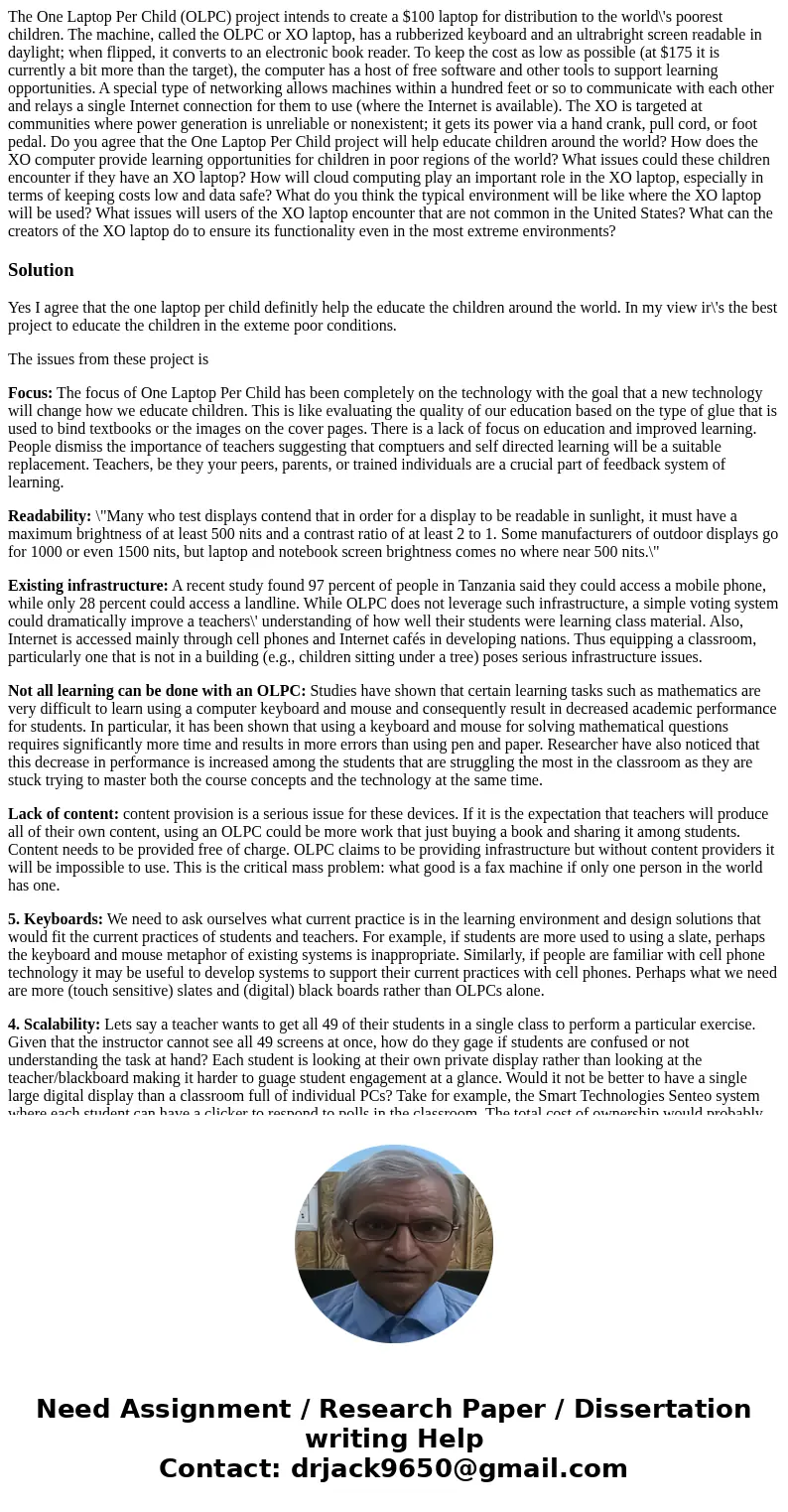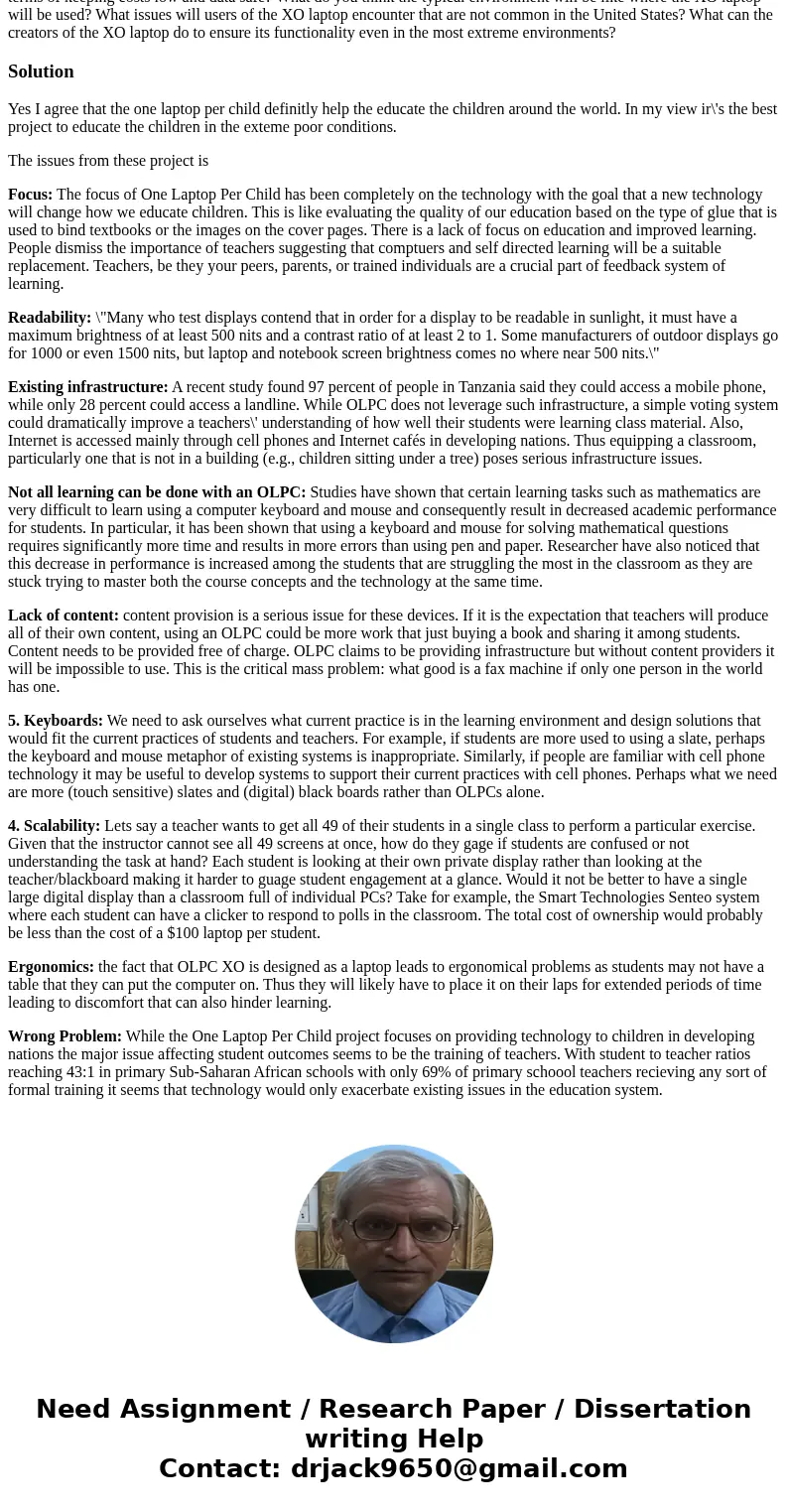The One Laptop Per Child OLPC project intends to create a 10
The One Laptop Per Child (OLPC) project intends to create a $100 laptop for distribution to the world\'s poorest children. The machine, called the OLPC or XO laptop, has a rubberized keyboard and an ultrabright screen readable in daylight; when flipped, it converts to an electronic book reader. To keep the cost as low as possible (at $175 it is currently a bit more than the target), the computer has a host of free software and other tools to support learning opportunities. A special type of networking allows machines within a hundred feet or so to communicate with each other and relays a single Internet connection for them to use (where the Internet is available). The XO is targeted at communities where power generation is unreliable or nonexistent; it gets its power via a hand crank, pull cord, or foot pedal. Do you agree that the One Laptop Per Child project will help educate children around the world? How does the XO computer provide learning opportunities for children in poor regions of the world? What issues could these children encounter if they have an XO laptop? How will cloud computing play an important role in the XO laptop, especially in terms of keeping costs low and data safe? What do you think the typical environment will be like where the XO laptop will be used? What issues will users of the XO laptop encounter that are not common in the United States? What can the creators of the XO laptop do to ensure its functionality even in the most extreme environments?
Solution
Yes I agree that the one laptop per child definitly help the educate the children around the world. In my view ir\'s the best project to educate the children in the exteme poor conditions.
The issues from these project is
Focus: The focus of One Laptop Per Child has been completely on the technology with the goal that a new technology will change how we educate children. This is like evaluating the quality of our education based on the type of glue that is used to bind textbooks or the images on the cover pages. There is a lack of focus on education and improved learning. People dismiss the importance of teachers suggesting that comptuers and self directed learning will be a suitable replacement. Teachers, be they your peers, parents, or trained individuals are a crucial part of feedback system of learning.
Readability: \"Many who test displays contend that in order for a display to be readable in sunlight, it must have a maximum brightness of at least 500 nits and a contrast ratio of at least 2 to 1. Some manufacturers of outdoor displays go for 1000 or even 1500 nits, but laptop and notebook screen brightness comes no where near 500 nits.\"
Existing infrastructure: A recent study found 97 percent of people in Tanzania said they could access a mobile phone, while only 28 percent could access a landline. While OLPC does not leverage such infrastructure, a simple voting system could dramatically improve a teachers\' understanding of how well their students were learning class material. Also, Internet is accessed mainly through cell phones and Internet cafés in developing nations. Thus equipping a classroom, particularly one that is not in a building (e.g., children sitting under a tree) poses serious infrastructure issues.
Not all learning can be done with an OLPC: Studies have shown that certain learning tasks such as mathematics are very difficult to learn using a computer keyboard and mouse and consequently result in decreased academic performance for students. In particular, it has been shown that using a keyboard and mouse for solving mathematical questions requires significantly more time and results in more errors than using pen and paper. Researcher have also noticed that this decrease in performance is increased among the students that are struggling the most in the classroom as they are stuck trying to master both the course concepts and the technology at the same time.
Lack of content: content provision is a serious issue for these devices. If it is the expectation that teachers will produce all of their own content, using an OLPC could be more work that just buying a book and sharing it among students. Content needs to be provided free of charge. OLPC claims to be providing infrastructure but without content providers it will be impossible to use. This is the critical mass problem: what good is a fax machine if only one person in the world has one.
5. Keyboards: We need to ask ourselves what current practice is in the learning environment and design solutions that would fit the current practices of students and teachers. For example, if students are more used to using a slate, perhaps the keyboard and mouse metaphor of existing systems is inappropriate. Similarly, if people are familiar with cell phone technology it may be useful to develop systems to support their current practices with cell phones. Perhaps what we need are more (touch sensitive) slates and (digital) black boards rather than OLPCs alone.
4. Scalability: Lets say a teacher wants to get all 49 of their students in a single class to perform a particular exercise. Given that the instructor cannot see all 49 screens at once, how do they gage if students are confused or not understanding the task at hand? Each student is looking at their own private display rather than looking at the teacher/blackboard making it harder to guage student engagement at a glance. Would it not be better to have a single large digital display than a classroom full of individual PCs? Take for example, the Smart Technologies Senteo system where each student can have a clicker to respond to polls in the classroom. The total cost of ownership would probably be less than the cost of a $100 laptop per student.
Ergonomics: the fact that OLPC XO is designed as a laptop leads to ergonomical problems as students may not have a table that they can put the computer on. Thus they will likely have to place it on their laps for extended periods of time leading to discomfort that can also hinder learning.
Wrong Problem: While the One Laptop Per Child project focuses on providing technology to children in developing nations the major issue affecting student outcomes seems to be the training of teachers. With student to teacher ratios reaching 43:1 in primary Sub-Saharan African schools with only 69% of primary schoool teachers recieving any sort of formal training it seems that technology would only exacerbate existing issues in the education system.


 Homework Sourse
Homework Sourse